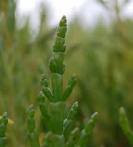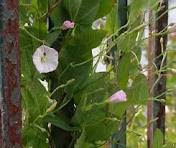 MARSH SAMPHIRE, SALICORNIA EUROPAEA
MARSH SAMPHIRE, SALICORNIA EUROPAEAMarsh samphire abounds along the Welsh coastline and Welsh lambs fed on this plant are highly sought-after and sold by “high-class” butchers. In previous times fish and chip shops offered special customers marsh samphire to go with their fish, and not surprisingly it goes well with this. Marsh samphire grows on muddy sea flats and coastal areas and in estuaries and small creek beds. It is indigenous to northern Europe including the British Isles and to North America.
In the past it was known as glasswort and glasswede. The latter is the name given to it by the 16th century herbalist William Turner who described the plant but then had to name it. Nicholas Culpeper, writing his Complete Herbal in the following century calls it Saltwort too and says:- “All sorts of saltwort, or glasswort, are under the dominion of Mars, and are of a cleansing quality, without any great or manifest heat; the powder of any of them, or the juice, which is much better, taken in drink, purges downwards phlegmatic, waterish,

melancholy, and adust humours, and is therefore very effectual for the dropsy, to
provoke urine, and expel the dead child. It opens stoppings of the liver and spleen, and wastes the hardness thereof; but it must be used with discretion, as a great quantity is hurtful and dangerous.”
He continues to comment on the ashes, which, when mixed with sand produced glass, hence the name glasswort or glasswede for the plant.
“The ashes are very sharp and biting, like a caustic, and the lye that is made thereof is so strong that it will fetch off the skin from the hands, or any part of the body; but ay be mixed with other more moderate medicines, to take any scabs, leprosy, and to cleanse the skin.”
Sir Thomas More, who wrote during the Renaissance, listed the useful native plants that would improve “many a poor knave's pottage” if he were skilled in their properties, says that “Glasswort might afford him a pickle for his mouthful of salt meat.”

John Parkinson, (1567-1650) relates a theory in connection with Glasswort in his days:
“If the soap that is made of the lye of the ashes be spread upon a piece of thicke coarse brown paper cut into the forme of their shoe sole that are casually taken speechless and bound to the soles of their feete, it will bring again the speech and that within a little time after the applying thereof if there be any hope of being restored while they live: this hath been tried to be effectuall upon diverse persons.”
So apart from being recognized by gourmets, in the past this modest plant, which looks a little like a sea coral, and on its first appearance like
asparagus, has been used medicinally. It grows between June and September, but if you harvest it, please don’t uproot the whole plant, just snip off the tops and leaves the roots so that it can grow the folloing year. It is a protected species in the
UK, so it is illegal to uproot it.

Like other sea plants such as
laver bread, it is rich in iodine and is full of phytochemicals that protect the liver, heart and cellular DNA. It is also rich in
vitamins A, C, and some
B-complex ones, and the
minerals, iron, calcium and magnesium phosphorus, calcium, silica, zinc, manganese and vitamin D. Because of this nutritional value it was used by sailors on long ocean voyages to combat scurvy. We now know that it also has a good balance of
amino acids and the levels of linoleic acid in the plant are similar to those found in safflower oil. Its
flavonoids include quercetin and isorhamnetin as well as certain glycosides which may have anti-cancer effects, but studies are still in an early stage. It is a healthy plant to eat although it does contain sodium, but 100gr of marsh samphire contain 100 calories and no cholesterol.

Despite the name marsh samphire is not related to
rock samphire (pronounced ‘samfire’) as it is a member of the goosefoot family as is
stinking goosefoot and
fat hen or
Chenopodium album. There are several types of Marsh samphire (pronounced ‘samfur’) in Britain and
Salicornia bigelovii which grows around the coasts of the Americas has been the subject of a trial in Saudi Arabia as the marsh samphire is so rich in oil and after extracting the oil from the plant the resulting ‘cake’ can be used as livestock feed (Arthur Clark, Nov-Dec 1994, in
Saudi Aramco World magazine). There are high hopes in
Saudi Arabia that the plant can be a commercial success and the basis for new cities around the Saudi coastal desert areas.

You can cook marsh samphire easily once it has been thoroughly cleaned and washed then rinsed to remove any grit or sand that clings to it. It looks a little like
chong (Caralluma fimbriata), but it is a succulent without any spines. You can eat the young shoots raw, but the saponins make the plant a little bitter so it is best to cook them for about eight minutes in boiling salted water. Try this recipe and add the marsh samphire to a creamy pasta dish with smoked salmon for a delicious dish.
 BOILED MARSH SAMPHIRE
BOILED MARSH SAMPHIREIngredients
200 gr marsh samphire, cleaned and washed as above and in 3 inch pieces
tsp butter
Method
Bring a large pan of salted water to the boil and drop the marsh samphire in.
Cook for about 4 minutes for a crunchy texture, longer if you need to.
Drain, and toss in olive oil and the butter.
Serve with grilled fish and garnish with lemon wedges or pieces.
This has Taste and is a Treat.
 The name convolvulus comes from the Latin “convolvere” meaning to twine and arvensis means of the field or cultivated land. The stems of this plant can grow to around two metres long and they can twine in a total revolution in less than 2 hours, making them a very rapid-growing plant. The roots burrow deep into the soil too, making it a difficult plant to eradicate. In the
The name convolvulus comes from the Latin “convolvere” meaning to twine and arvensis means of the field or cultivated land. The stems of this plant can grow to around two metres long and they can twine in a total revolution in less than 2 hours, making them a very rapid-growing plant. The roots burrow deep into the soil too, making it a difficult plant to eradicate. In the  In Europe there are various superstitions about this plant, one is my grandfather’s that vipers make their nests under it, and in other parts of Britain it is said that if a young woman picks the flowers of the Field bindweed, the object of her affections will die. Another superstition is that if you pick the flowers there will be a thunder storm, and it is called the “thunder flower” for this reason.
In Europe there are various superstitions about this plant, one is my grandfather’s that vipers make their nests under it, and in other parts of Britain it is said that if a young woman picks the flowers of the Field bindweed, the object of her affections will die. Another superstition is that if you pick the flowers there will be a thunder storm, and it is called the “thunder flower” for this reason. One study exists: Meng, X. L. et al. December 2002, “Effects of a high molecular mass Convolvulus arvensis on tumour growth and angiosperm” P.R. Health Science Journal, Vol. 21 (4) pp 323-328. However the results are inconclusive as the extracts of the plant did not kill cancer cells in an in vitro culture, but, according to the researchers, “inhibited tumour growth in mice” by approximately 70 %.
One study exists: Meng, X. L. et al. December 2002, “Effects of a high molecular mass Convolvulus arvensis on tumour growth and angiosperm” P.R. Health Science Journal, Vol. 21 (4) pp 323-328. However the results are inconclusive as the extracts of the plant did not kill cancer cells in an in vitro culture, but, according to the researchers, “inhibited tumour growth in mice” by approximately 70 %. The whole plant produces a green dye, and the stems can be used to tie up other plants, such as tomatoes, but they are not durable.
The whole plant produces a green dye, and the stems can be used to tie up other plants, such as tomatoes, but they are not durable.


















































